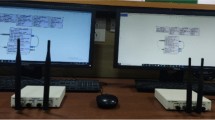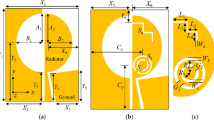Abstract
The opportunistic spectrum access (OSA) and spectrum sharing (SS) are most commonly used schemes in accessing the underutilized licensed spectrum by a cognitive radio (CR) system. Unlike to SS scheme in which the CR users are permitted to co-exist on the same band being used by licensed users (LUs), in OSA scheme the unlicensed users (UUs) are allowed to access an idle band only. During a CR communication in OSA scheme, in order to remain aware of the re-appearance of LUs on the band of interest, the process of spectrum sensing is of high importance. During sensing, in order to decide the idle/busy status of the licensed band, the proper selection of decision threshold \({\uplambda }\) is of high importance. \({\uplambda }\) is mainly selected by using two principles called as constant detection rate (CDR) in which \({\uplambda }\) is calculated by taking fixed value of probability of detection \(\left( {{{\varvec{P}}}_{{\varvec{d}}} } \right) \) and constant false alarm rate (CFAR) in which \({\uplambda }\) is calculated by taking fixed value of probability of false alarm \(\left( {{\varvec{P}}}_{{\varvec{fa}}} \right) \). The CDR principle is favorable in protecting the communication of LUs while CFAR principle suits in improving the throughput of CR system. So, blind use of any of the principle lead to a compromise either in the security of LUs or throughput of CR. This paper proposes an approach which based on the mobile/stationary nature of UU node, and the distance of UU node from LU, makes selection of an appropriate scheme among the CDR-OSA, CFAR-OSA, and SS, to opportunistically improve the CR-throughput.







Similar content being viewed by others
References
Federal communications commission. (2002). Spectrum Policy Task Force. Report ET Docket no., p. 02-135.
Mitola, J., & Maguire, G. Q. (1999). Cognitive radio: Making software radios more personal. IEEE Personal Communications, 6(4), 13–18. doi:10.1109/98.788210.
Mitola, J. (2000). Cognitive radio: An integrated agent architecture for software defined radio. Ph.D. diss., Royal Inst. Technology, Stockholm, Sweden, pp. 1–313.
Haykin, S. (2005). Cognitive radio: Brain-empowered wireless communications. IEEE Journal of Select Areas of Communication, 23(2), 201–220. doi:10.1109/JSAC.2004.839380.
Liang, Y.-C., Zeng, Y., Peh, E. C. Y., & Hoang, A. T. (2008). Sensing throughput tradeoff for cognitive radio networks. IEEE Transactions on Wireless Communication, 7(4), 326–1337. doi:10.1109/TWC.2008.060869.
Gupta, M.K., Dubey, R.K., & Verma, G. (2016). Cooperative spectrum sensing for cognitive radio based on adaptive threshold. Second IEEE International Conference on Computational Intelligence and Communication Technology (CICT), ABES engineering college, Gaziabad, pp. 1–5.
Ghasemi, A., & Sousa, E. S. (2007). Fundamental limits of spectrum-sharing in fading environments. IEEE Transactions on Wireless Communications, 6(2), 649–658. doi:10.1109/TWC.2007.05447.
Wang, N., Gao, Y., & Zhang, X. (2013). Adaptive spectrum sensing algorithm under different primary user utilizations. IEEE Communication Letter, 17(9), 1838–1841. doi:10.1109/LCOMM.2013.081313.131468.
Choi, H.-H., Jang, K., & Cheong, Y. (2008). Adaptive sensing threshold control based on transmission power in cognitive radio systems. IEEE Conf., Cognitive Radio Oriented Wireless Networks and Communication (CrownCom), Singapore, pp. 1-6. doi:10.1109/CROWNCOM.2008.4562452
Verma, G., & Sahu, O. P. (2015). Interference aware optimization of throughput in cognitive radio system. Defence Science Journal, India, 65(4), 312–318. doi:10.14429/dsj.65.8739.
Lin, Y.-E., Liu, K.-H., & Hsieh, H.-Y. (2013). On using interference-aware spectrum sensing for dynamic spectrum access in cognitive radio networks. IEEE Transactions on Mobile Computing, 12(3), 461–474. doi:10.1109/TMC.2012.16.
Stotas, S., & Nallanathan, A. (2010). Overcoming the sensing-throughput tradeoff in cognitive radio networks. IEEE International Conference on Communications (ICC), pp. 1–5. doi:10.1109/ICC.2010.5502792
Hu, H., Zhang, H., & Li, N. (2016). Location-information-assisted joint spectrum sensing and power allocation for cognitive radio networks with primary-user outage constraint. IEEE Transactionson Vehicular Technology, 65(2), 658–672. doi:10.1109/TVT.2015.2403951.
Verma, G., & Sahu, O. P (2016). Intelligent selection of threshold in cognitive radio system. Telecommunication Systems, Springer, pp. 1–10. doi:10.1007/s11235-016-0141-y
Verma, G., & Sahu, O. P. (2015). Throughput enhancement to the cognitive radio networks under the precaution is better than the cure (PBC) approach. Proceedings, IEEE International Conference on Signal Processing and Communication Engineering Systems (SPACES), K.L. University, pp. 492–496. doi:10.1109/SPACES.2015.7058203.
Mariani, A., Giorgetti, A., & Chiani, M. (2011). Effects of noise power estimation on energy detection for cognitive radio applications. IEEE Transactions on Communications, 59(12), 3410–3420. doi:10.1109/TCOMM.2011.102011.100708.
Peh, E., & Liang, Y.-C. (2007). Optimization for cooperative sensing in cognitive radio networks. IEEE Conference, Wireless Communication and Networking Conference (WCNC), pp. 27–32. doi:10.1109/WCNC.2007.11.
Ye, Z., Memi, K. G., & Grosspietsch, J. (2008). Energy detection using estimated noise variance for spectrum sensing in cognitive radio networks. IEEE Conference on Wireless Communication and Networking Conference (WCNC), pp. 711–716. doi:10.1109/WCNC.2008.131.
Moghimi, F., Nasri, A., & Schober, R. (2009). Lp-norm spectrum sensing for cognitive radio networks impaired by non-gaussian noise. In Processing IEEE Conference on GLOBECOM, pp. 1–6. doi:10.1109/GLOCOM.2009.5425992.
Verma, G., & Sahu, O. P. (2015). Throughput enhancement to the cognitive radio networks under the precaution based cooperation of the primary users. Proceedings, IEEE International Conference, Signal Processing, Informatics, Communication and Energy Systems (SPICES), NIT Calicut, Kerala, pp. 1–5. doi:10.1109/SPICES.2015.7091504.
Zou, Y., et al. (2010). Spectrum sensing and data transmissiontradeoff in cognitive radio networks. Wireless and OpticalCommunications Conference (WOCC), pp. 1–5. doi:10.1109/WOCC.2010.5510601.
Tang, L., et al. (2011). Effect of primary user traffic on sensing-throughput tradeoff for cognitive radios. IEEE Transactions on Wireless Communications, 10(4), 1063–1068.
Pradhan, H., et al. (2015). Sensing-throughput tradeoff in cognitive radio with random arrivals and departures of multiple primary users. IEEE Communication Letters, 19(3), 415–418.
Dubey, R.K., & Verma, G. (2015). Improved spectrum sensing for cognitive radio based on adaptive threshold. IEEE International Conference on Advances in Computing and Communication Engineering (ICACCE), pp. 253–256. doi:10.1109/ICACCE.2015.70
Benitez, M. L., & Casadewall, F. (2013). Signal uncertainty in spectrum sensing for cognitive radio. IEEE Transactions on Communications, 61(4), 1231–1241. doi:10.1109/TCOMM.2013.021413.110807.
Kim, K.-Y., Jung, H., Kim, J., & Shin, Y. (2013). Location-Based subcarrier allocation scheme for secondary systems in cognitive radios. International Conference on Ubiquitous and Future Networks (ICUFN), pp. 161–164. doi:10.1109/ICUFN.2013.6614803
Han, W., et al. (2016). Spatial false alarm in cognitive radio network. IEEE Transactions on Signal Processing, 61(6), 1375–1388.
Chen, P., Zhang, Q., Yu, J., Zhang, Y., & Cao, B. (2013). Sensing-throughput tradeoff in joint spatial-temporal sensing based cognitive radio networks. International Conference on Communications in China (ICCC), pp. 727–732. doi:10.1109/ICCChina.2013.6671206
Wu, Q., Ding, G., Wang, J., & Yao, Y.-D. (2013). Spatial-temporal opportunity detection for spectrum-heterogeneous cognitive radio networks: Two-dimensional sensing. IEEE Transactions on Wireless Communications, 12(2), 516–526. doi:10.1109/TWC.2012.122212.111638.
Tefek, U., & Lim, T. J. (2016). Interference management through exclusion zones in two-tier cognitive networks. IEEE Transactions on Wireless communications, 15(3), 2292–2302. doi:10.1109/TWC.2015.2502254.
Xue, T., Shi, Y., & Dong, X. (2012). A framework for location-aware strategies in cognitive radio systems. IEEE Wireless Communications Letters, 1(1), 31–33. doi:10.1109/WCL.2012.120211.110110.
Peh, E., Liang, Y.-C., & Zeng, Y. (2012). Sensing and power control in cognitive radio with location information. IEEE International Conference Communications System, pp. 255–259. doi:10.1109/ICCS.2012.6406149.
Mu, H., & Tugnait, J. K. (2012). Joint soft-decision cooperative spectrum sensing and power control in multiband cognitive radios. IEEE Transactions on Signal Processing, 60(10), 5334–5346. doi:10.1109/TSP.2012.2205684.
Wang, Y., Ren, P., Gao, F., & Su, Z. (2014). A hybrid underlay/overlay transmission mode for cognitive radio networks with statistical quality-of-service provisioning. IEEE Transactions on Wireless Communications, 13(3), 1482–1497. doi:10.1109/TWC.2013.010214.130797.
Chen, P., Zhang, Q., Yu, J., Zhang, Y., & Cao, B. (2013). Sensing-throughput tradeoff in joint spatial-temporal sensing based cognitive radio networks”, International Conference on Communications in China (ICCC),China, pp. 727–732. doi:10.1109/ICCChina.2013.6671206.
Verma, G., & Sahu, O. P. (2016). Location based throughput gain in cognitive radio. Accepted, IEEE International conference on Communication control and Intelligent Systems, GLA Mathura.
Verma, G., & Sahu, O. P. (2016). Efficient use of location of licensed users in improving the throughput of cognitive radio. Accepted, A Springer Conference on Emerging Trends and Advances in Electrical Engineering and Renewable Energy (ETAEERE), Sikkim Manipal University.
Verma, G., & Sahu, O. P. (2016). Distance based utilization of licensed spectrum in cognitive radio. An IEEE International Conference on the Recent Advances and Innovations in Engineering (ICRAIE), Jaipur.
Radhi, N., et al. (2011). Estimate primary user localization using cognitive radio networks. IEEE International Conference on Innovations in Information Technology (IIT), pp. 381–385.
Werner, J., et al. (2013). Estimating the primary user location and transmit power in cognitive radio systems using extended kalman filters. IEEE International Conference on Wireless On-demand Network Systems and Services (WONS), pp. 68–73.
Wang, J., et al. (2010). Weighted centroid algorithm for estimating primary user location: theoretical analysis and distributed implementation, pp. 1–25. arXiv:1011.2313.
Wild, B., et al. (2005). Detecting primary receivers for cognitive radio applications. IEEE Symposium on New Frontiers in Dynamic Spectrum Access Networks (DySPAN), pp. 124–130.
Xiao, L., et al. (2007). Sensor-assisted localization in cellular systems. IEEE Transactions on Wireless Communications, 6(12), 4244–4248.
Author information
Authors and Affiliations
Corresponding author
Rights and permissions
About this article
Cite this article
Verma, G., Sahu, O.P. On opportunistic use of location of licensed users in improving the throughput of cognitive radio. Telecommun Syst 66, 523–531 (2017). https://doi.org/10.1007/s11235-017-0304-5
Published:
Issue Date:
DOI: https://doi.org/10.1007/s11235-017-0304-5




